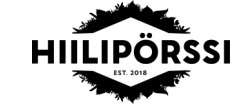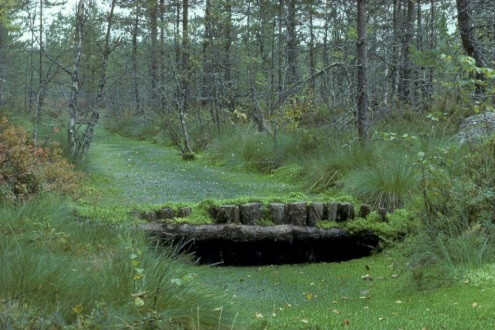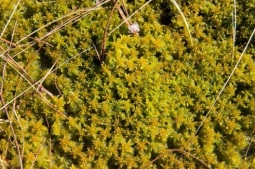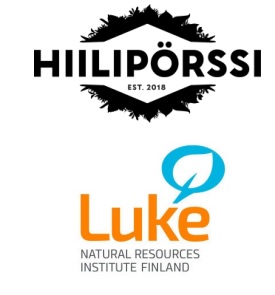Summary
The Carbon Market, launched in May 2018, is a value chain contract solution that aims to reduce greenhouse gas emissions by restoring ditched peatlands to their natural state. The contract solution has also collective features in cases where the restored peatlands have several owners. The landowners of the peatland voluntarily assign a drained peatland to be restored and commit to leave it untouched permanently. During 2018-2020 the service relied on donations of private individuals and institutions and operated under the Finnish Association of Nature Conservation (FANC). In October 2020, a nonprofit company Carbon Market Ltd was established to provide similar services for private and public companies and institutions in exchange for carbon offset payments. About 70% of the proceeds are directly allocated to restoration activities and the remaining 30% to other organizational costs, education on nature conservation and support of scientific work. Compensation purchasers receive a certificate, stating the amount of restored peatland and carbon benefit. Currently, the company’s operational activities are focused on a 350 hectares peatland area in eastern Finland which has been assigned for restoration by Tornator Ltd, the largest private forest landowner in Finland. Another current restoration project concerns a 100 hectares ditched peatland in central Finland assigned by a local parish. The original restoration service based on donations continues under FANC. The demerge of two services was motivated by legal reasons.
Objectives
1. Increasing carbon storage2. Safeguarding biodiversity
3. Safeguarding water quality

Data and Facts - Contract
Participation: During 2018-2020 some 1,300 hectares of peatland was restored (or agreed to be restored) using donations from 2,500 private individuals and institutions. The donated capital was 1.4 mill. €, the most common donation 50 €, and the agreements involved ten landowners. In October 2020, a nonprofit company Carbon Market Ltd was established to provide similar services to private and public companies and institutions on more commercial basis. The new Company offers carbon compensation services in exchange for carbon offset payments. It uses 70% of the proceeds to restoration activities and 30% to other expenses and support of related education.
Involved parties: Donors and landowners and (since Oct. 2020) investors and Carbon Market Ltd, a spin-off company of the Finnish Association for Nature Conservation (FANC), with whom the landowner makes the restoration contract. The landowner voluntarily assigns a ditched peatland to restoration and approves the project plan.
The government regional authority (ELY Center) gives permission for the restoration work. The landowner and the donor or investor do not make mutual agreements.
Management requirements for farmers: All landowners of the uniform peatland to be restored must enter into a contract. A restoration plan will then be made for the peatland area in question. It will be implemented under the control and expense of the Carbon Market. The landowner does not need to do anything, but if he wishes, he can contribute to the plan. Once the restoration work is done, the landowner is not allowed for any activities in the area. The restored peatland may be transformed into a private protected area with a legal status.
Controls/monitoring: The experts of the Carbon Market make self-monitoring when resources allow, for example by checking the condition of the dams.
Conditions of participation: One landowner is enough for participation if he is the only owner of the peatland area that is suitable for restoration. However, often there are several owners within one peatland. In this situation, all landowners need to agree on the restoration plan and sign the contract. The plan will be annexed to the Agreement that is made with the landowner.
Risk/uncertainties of participants: The restored peatland may at first result in increased release of methane emissions as water level raises. Moreover, heavy rains and floods are expected to increase with climate change, which may also raise the risk for methane emissions as water floods into the peatland. On the other hand, as the climate warms and dry seasons increase, peat decomposition may accelerate and peat fires may become more probable with low water levels.
Funding/Payments: In the scheme, there are usually no payments for the landowner, as the peatlands they own are usually not productive in terms of forestry and thus restoration activities do not result in lost timber income. The minimum donation or offset payment is currently 56 euros which funds the restoration of 600 m2 of peatland, capturing a minimum 55 kilos of carbon annually. By donating or investing 4,500 euros, one can store 3,750 kilos of carbon per year, which is approximately equivalent to the amount of carbon emissions of an average Finn per year. The website has a carbon counter that calculates how much restored peatland and carbon sequestration one can get with a specific donation or investment. The time horizon in the calculations is 100 years and the price of carbon offsets is approximately 44 €/t CO2-ekv (May 2022). To be on the safe side, Carbon Market Ltd sells only carbon benefits (prevented carbon emissions for peatland soil) that accrue during a 15-year time span, i.e. benefits from the rest of the commitment period (75 yrs) are not sold.

Problem description
Peatlands are the second largest carbon reservoir globally, and in Finland they cover almost one third of the land area. More than 2/3 of total carbon reservoir in Finland is in peatland soils., almost tenfold the amount in living trees in this Europe’s most forested country.
From 1960s to 1990s, more than half of the (original) mires were drained for forestry purposes (Southern Finland 80%, Northern Finland 40%). However, in many cases the ditching efforts did not result in satisfactory timber growth because the peatlands were not fertile enough or had poor nutrient balance for timber production. Draining of pristine mires has been mostly given up since 1990s, and recent emphasis on peatland forestry has been on ditch network maintenance (clearing and supplementary diching). Ditching drastically alters the hydrology of mires and may destroy mire vegetation and lead to biodiversity loss, cessation of peat accumulation and increased carbon emissions.
Restoration of drained peatlands, e.g. by filling in and damming ditches and removing part of the growing trees, aims to gradually restore natural mire hydrology and original mire vegetation, and turn the peatland back to carbon sink. So far, restoration activities for peatlands have concentrated almost entirely on state-owned protected land and thus their climate and other environmental impact has been limited. Carbon Market is one of the first instruments that funds restoration of private peatlands.
The Carbon Market service was founded by the Finnish Association for Nature Conservation in 2018. The initial development of the service was funded by the Kone Foundation. The aim was to develop a new, inspiring way to mitigate climate change and to raise funds for nature conservation. The original idea, implemented in 2018-2020, was to create and sustain an online donation service designed to reduce carbon emissions and increase carbon storage by restoring those ditched peatlands that had turned out to be unsuitable for forestry. Through donations, individuals and institutions could directly invest in emission reduction and carbon sinks in peatlands. The donor received a carbon certificate, stating the amount of restored peatland and the carbon stock. The landowners, in turn, may offer their drained peatlands to the Carbon Market for restoration. The suitability of the peatland is assessed by experts of the Carbon Market. The landowner allows them to make a restoration plan for the ditched peatland, and the regional government authority (Center for Economic Development, Transport and the Environment) gives permission for the restoration activity. Assigning a peatland for restoration does not imply a change in the ownership of the land but the contract is binding and permanent. The landowner may transform the restored peatland into a private protected area which is one way to ensure permanence.
Context features
Landscape and climate: Finland is one of the world's northernmost countries, the landscape being mostly flat with few hills and fewer mountains. 78% of Finland's land area is covered by forest land and 10% by water (lakes, rivers and ponds). The share of peatland is almost one third of the land area. Finland lies in the boreal zone, characterized by warm summers and freezing winters. However, the temperature varies considerably between the southern regions and the extreme north (Lapland), indicating characteristics of both maritime and continental climate. The annual amount of precipitation varies between 500 and 650 millimeters. Lapland has the lowest precipitation, while inland areas in the southern and central parts of the country get the most downpour.
Farm structure: Private forest owners (individuals and families) own 60 per cent of forest land and 70 per cent of the annual growth of timber stock. State-owned forests (25%) are managed by Metsähallitus; the rest is owned by forest companies, municipalities, parishes, foundations and jointly-owned forests. There are approximately 350,000 family forest holdings owning at least two hectares of forest land. These holdings have more than 600,000 owners. The annual timber growth in Finnish forests is 103 mill. m3 and the potential for sustained harvest removal 84 mill. m3. Family forest owners provide the forest industry 80 per cent of the domestic timber it uses. Forest land is typically managed for timber production. Since 1950s, the dominating forest management strategy has been even-aged management but in recent years also continuous cover forestry has gained some popularity. Attempts to increase timber growth has resulted in intensive ditching of mires, especially in southern Finland, and artificial regeneration of timber stands with spruce and pine seedlings.

Success or Failure?
The Carbon Market has been a success given its short life span. Within two and a half years (2018- 2020) it collected 1.4 mill. euros in private donations, and some 1,300 hectares of peatlands were restored or agreed to be restored. It is too early to assess all the environmental impacts of the contract solution because restoration of drained peatlands is a slow process. After demerging the service and establishing the (nonprofit) private company Carbon Market Ltd for commercial carbon offset purposes in Oct. 2020, the services have continued in two separate lines that may also share activities in the same peatlands. Donors and investors have been very interested in the restoration services, but it has been somewhat difficult to find sufficiently large continuous suitable peatlands for restoration. While some private landowners have offered their own parcels of peatland for restoration, others in the same area may have not been willing to participate in such activities. A successful restoration project requires that all landowners in the same continuous peatland area agree on the restoration goal because otherwise it is not possible to raise the local water level effectively and permanently. Several of the assigned larger peatlands have had only one owner such as state, private company or local parish, which has facilitated restoration.
Reasons for success :
• Usually no need for public funding.
• An inspiring channel to collect private money for the restoration and protection of peatlands.
• The contract may lead to the establishment of a private protected area, which is a permanent nature protection instrument in Finland.
SWOT analysis
Main Strengths
1. Market based - no need for public2. Landowners and donors and investors are very interested.
3. The contract may lead to the establishment of a permanent private protection area. funding.
Main Weaknesses
1. So far, many of the peatlands that have been restored have been protected areas, which means that in some time period, the end result would have be the same also without restoration. Restoration, however, accelerates the development back towards natural peatland (carbon sink).2. Due to small-scale forest ownership in Finland, not all the landowners of potential restoration project areas are always willing to participate in the scheme without compensation.
3. Monetary incentives to landowners are currently missing.
Main Opportunities
1. Peatlands have great potential as a carbon storage and sink.2. There are a lot of low-productive drained peatlands (estimates say almost million hectares) in Finland where drainage hasn’t been able to increase timber stock sufficiently. Restoring these peatlands does not reduce landowner's income.
3. Large funding potential: in addition to donations, several private companies are interested in funding restoration activities to compensate their carbon footprint. Their aim is to use this as indicator that they are responsible and take environment into account.
Main Threats
1. Landowners are skeptical towards Carbon Market due to its history with environmental organizations.2. Too few staff to keep things running.
Main external factors
Political/governance, economic/market, social, technological, legal and environmental factors can all have a strong impact on the success of contract solutions. In this case study an in-depth analysis found that the following, selected factors were of specific importance.
Major developments in the Carbon Market: In 2018-2020, Carbon Market was an online donation service both for individuals and institutions. It operated under the Finnish Association for Nature Conservation. A major change occurred in October 2020 when the commercial service of carbon compensations was separated from the donation activities and a private nonprofit company Carbon Market Ltd was established. The Company sells compensation services for private and public companies and institution. Moreover, aim is to offer possibility for other companies to compensate their carbon footprint. Private individuals cannot donate (compensate their carbon footprint) via Carbon market Ltd. However, they can still donate for restoring the peatlands by allocating their financial contribution to similar activities maintained by the Finnish Association for Nature Conservation.
Low risk, negligible or positive income effects, easily integrable into the farming system: The contract solution type is new in the sense that landowners offer peatlands to the market operator without getting payments, allowing their peatland area to be fully restored and then in some cases to be turned into a private nature conservation area. On the first sight, it seems rather unlikely that any landowner would step into such solution, reversing “land melioration” and preventing future economic activities on the area. However, considering low timber production on these sites and landowners’ future needs to invest in dich network maintenance, fertilization and forest regeneration, restoration may show also as an appealing economic option to many of them. From 1960s to 1990s, more than half of the (original) mires in Finland were drained for forestry purposes, but many ditching efforts have not resulted in satisfactory improvement of timber growth, especially on those sites that originally were not fertile enough for timber production purposes.
Many private forest owners have simultaneously multiple objectives for forest management, which means that beside timber income, they value various other products and services that forests are offering such as recreation and biodiversity. Therefore, a contract solution that outsources the restoration activities to a private non-profit actor such as Carbon Market Ltd, and the possibility to receive financial compensation from the state by allocating the restored peatland further to a private nature conservation area, is an attractive option for some peatland owners.
Online compensation service:
Via the online service compensation is easy, which lowers the threshold to participate. The website has a carbon counter to estimate how many hectares of peatland can be restored and how much carbon is sequestered with certain amount of Euros. On the website, there are news and YouTube-videos about the restoration works. These concretize the meaning of the compensation and will motivate companies and individuals to compensate their carbon footprint. This is also likely to motivate landowners to make contracts on restoration.

Information/contact: www.hiiliporssi.fi/

VALUE CHAIN and COLLECTIVE
landowner – marketplace – donor or investor. In case of some peatlands there are several owners, all of them need to agree on the restoration project and sign the contract.
PUBLIC GOODS
Biodiversity / (Farmland) biodiversity
Climate regulation-carbon storage
Water quality
INDIRECT EFFECTS
Natural mires have been a part of the national landscape, however, today they are rare in Southern Finland. In some of the restored peatlands, there have been events to raise awareness of the meaning of peatlands and in this way the contract solution may increase also cultural heritage.
LOCATION
Suomi/Finland

Whole Finland
CONTRACT
Contract conclusion:
Written agreement
Payment mechanism:
No payment for landowner, covers only the costs of restoration. Restoration is funded by donations and carbon offsets.
Funding/Payments:
Market sector-oriented
Start of the program:
May 2018
End:
still running
Feel free to contact us for any further informations.
CONTACT USLegal notice: The compilation of the information provided in the factsheets has been done to our best knowledge. Neither the authors nor the contact persons of the presented cases may be held responsible for the use which may be made of the information contained therein.